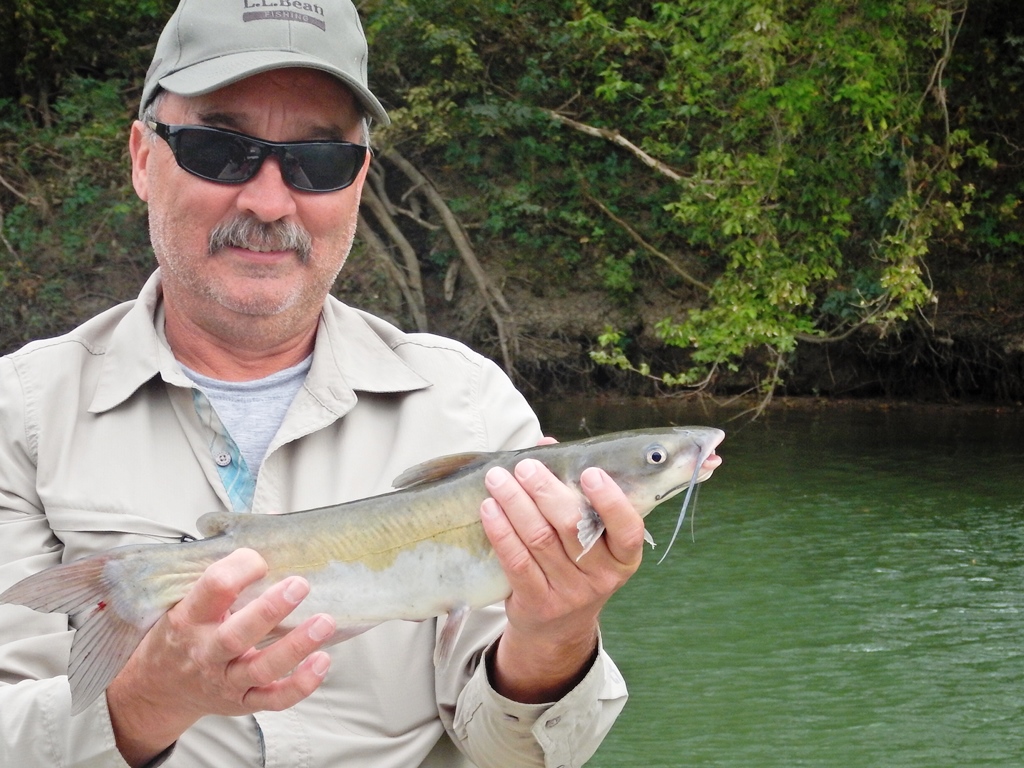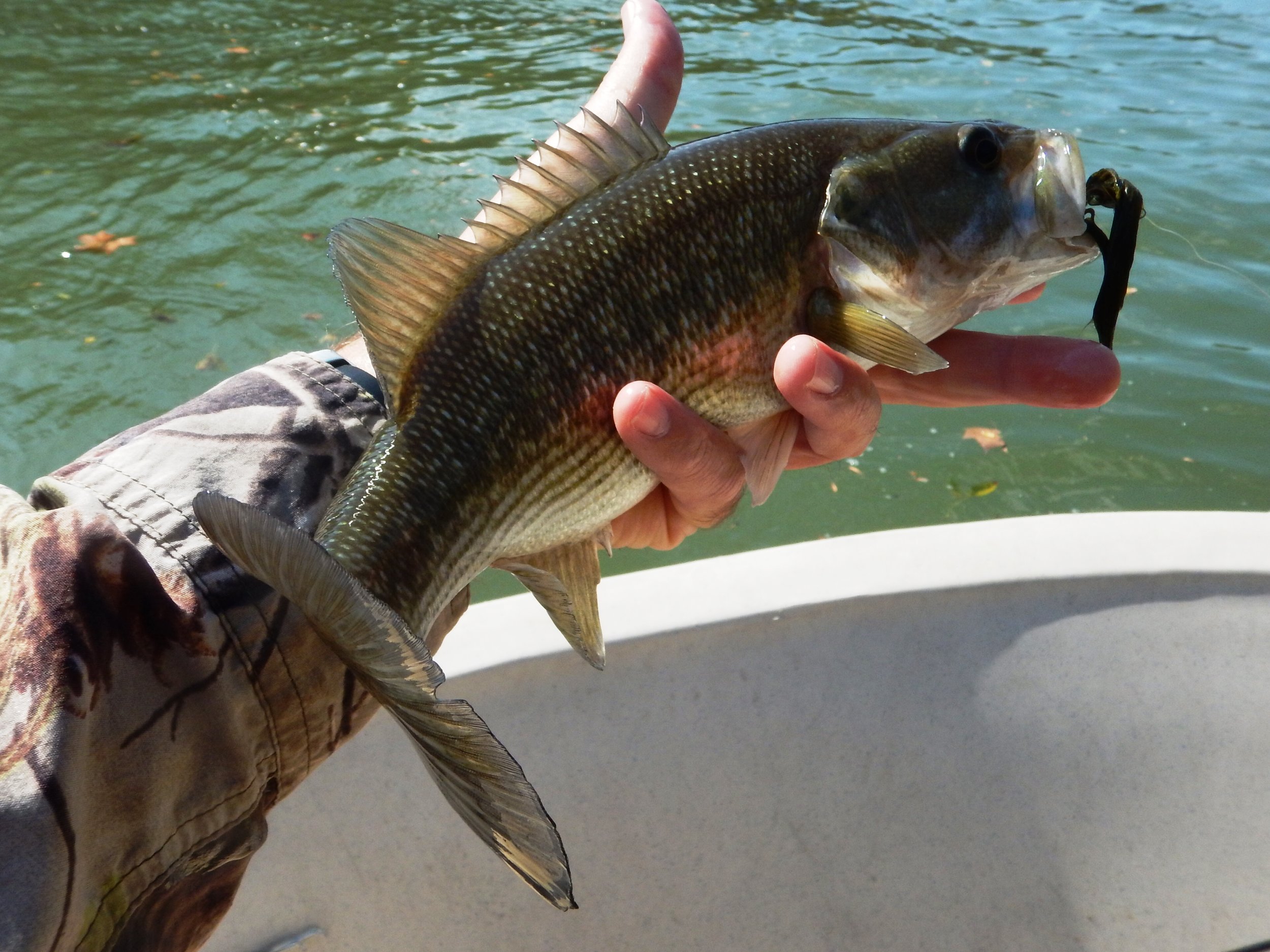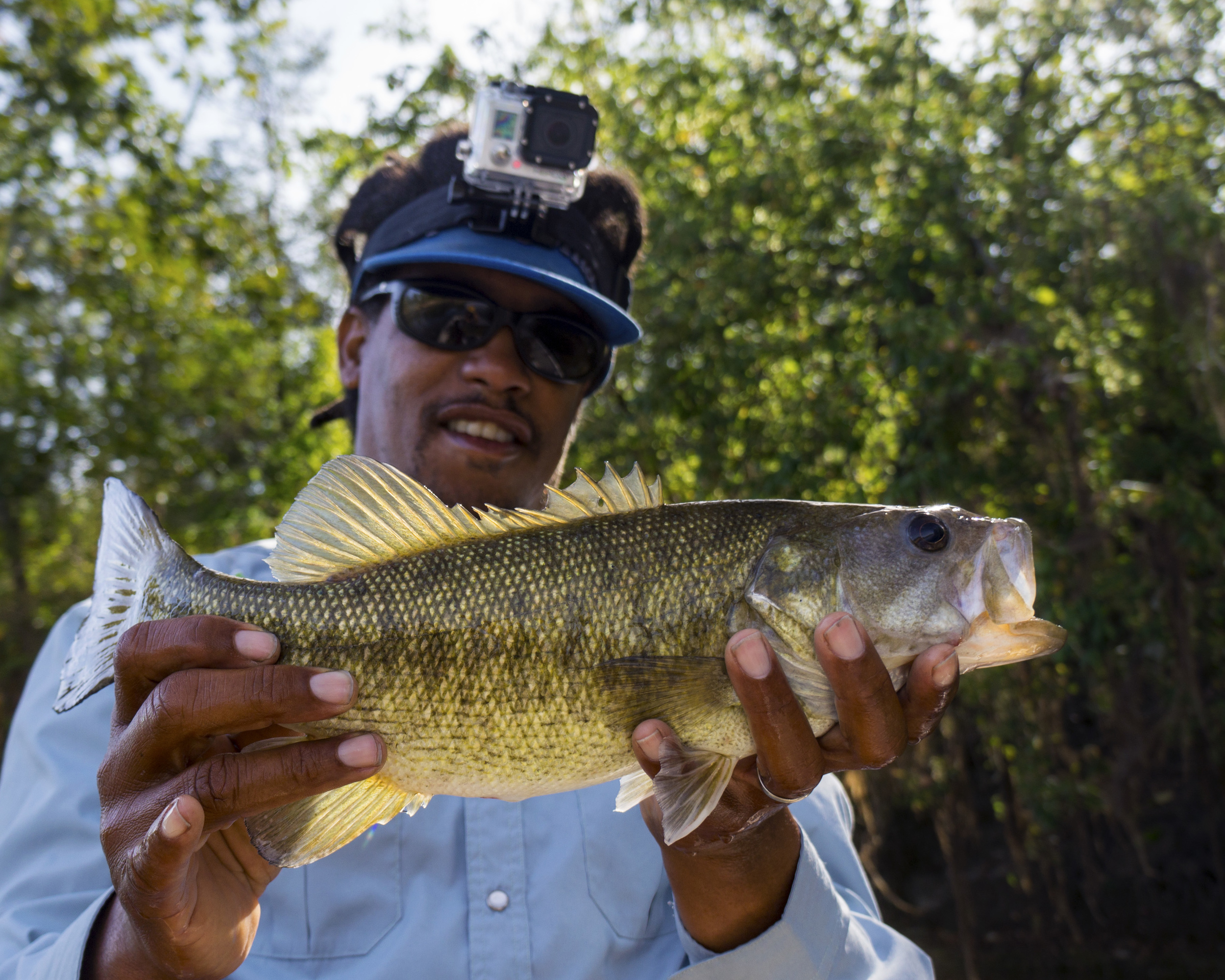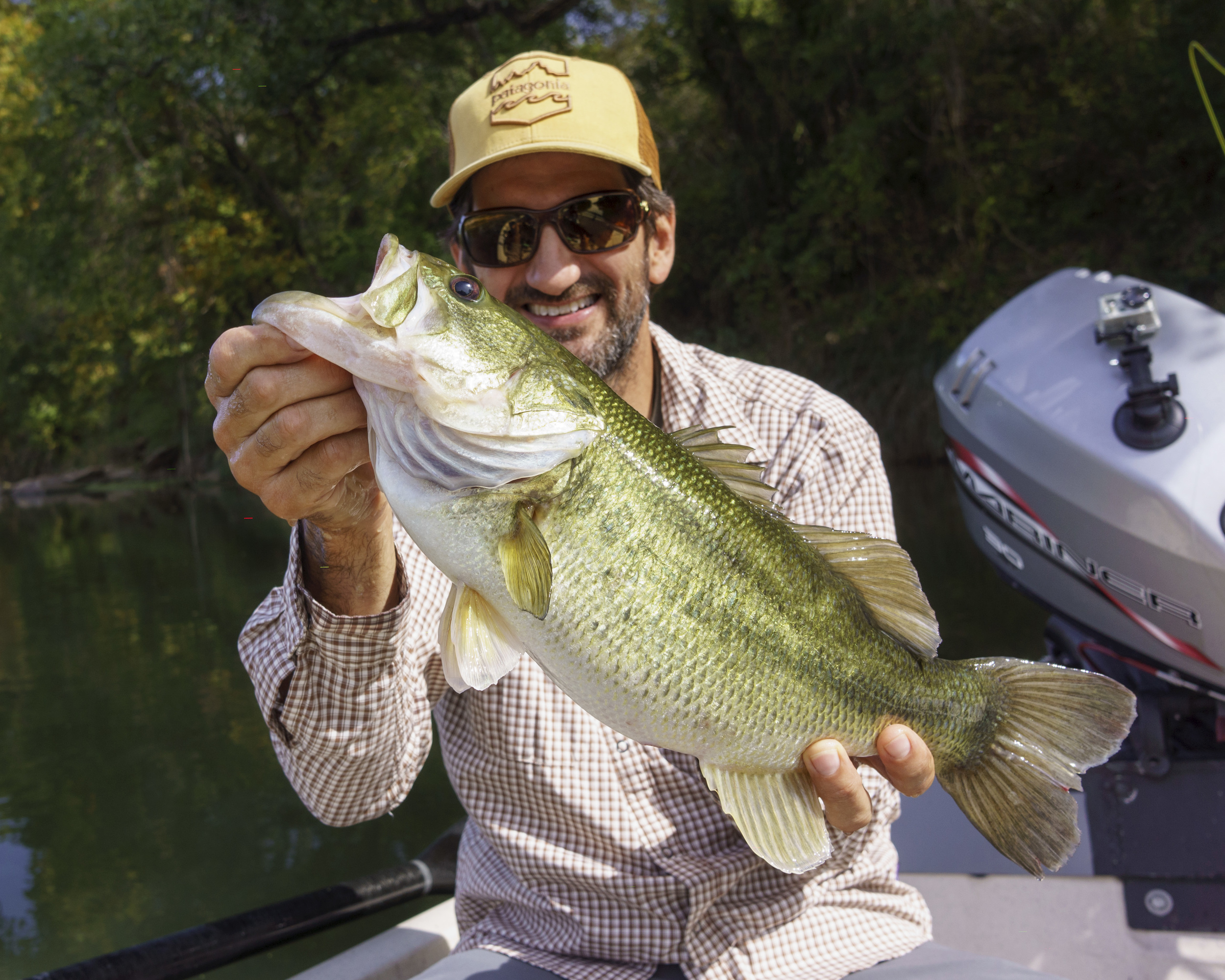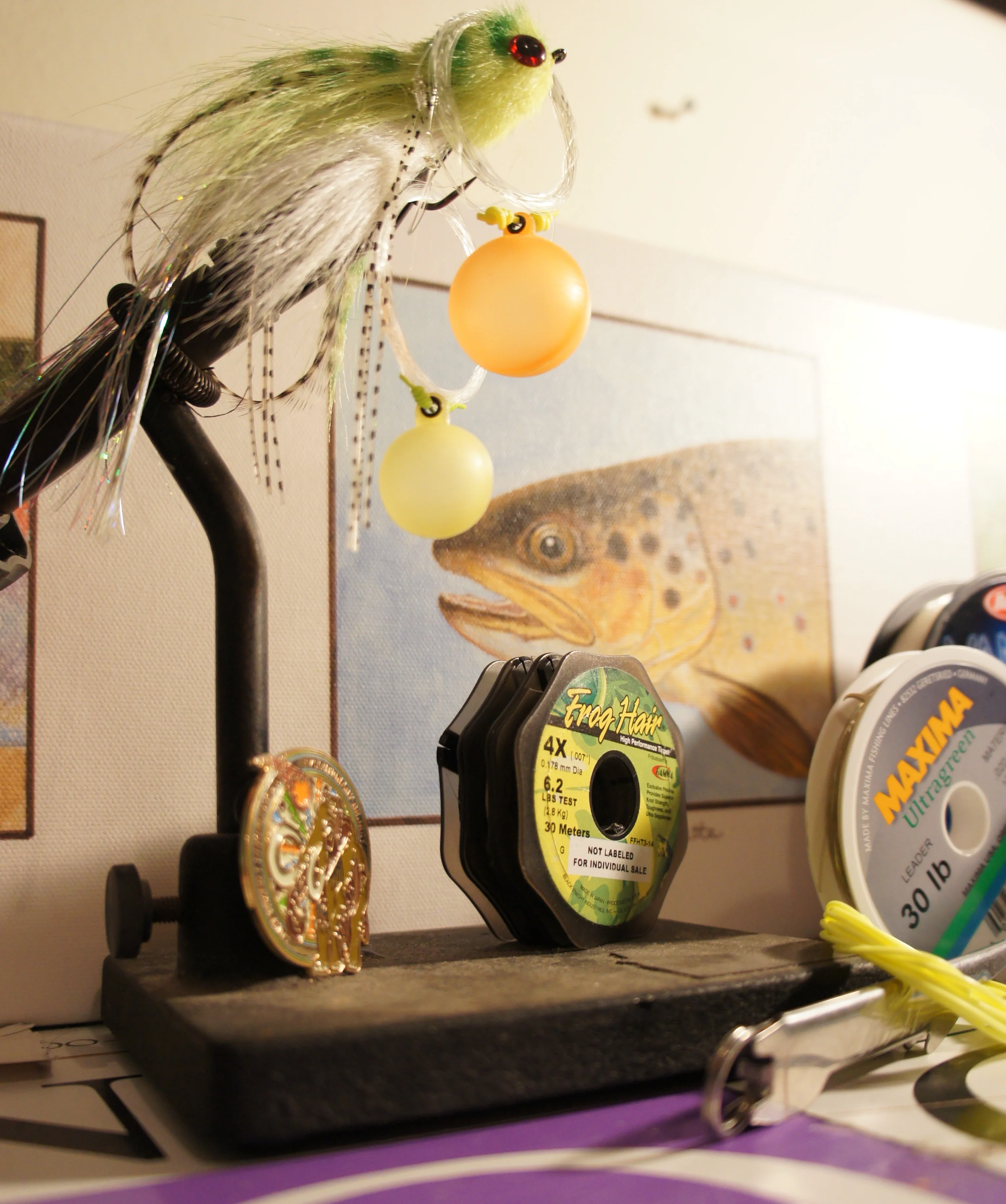TPWD Launches Prize Giveaway for Tagged Guadalupe Bass in Lower Colorado River
Feb. 3, 2022
Media Contact: TPWD News, Business Hours, 512-389-8030
AUSTIN – Grab a rod and reel and head to Central Texas for a chance to catch one of 30 tagged Guadalupe bass and possibly win a prize. From February 4 until August 31, any angler who catches one of the tagged Guadalupe bass from the Lower Colorado River near Austin and Smithville will be awarded a prize package and be entered into grand prize drawings at the end of the seven-month period.
This contest is the latest effort to help recognize the ecological and recreational importance of the Lower Colorado River - home to the current state record Guadalupe bass. The tournament is being hosted by the Texas Parks and Wildlife Department (TPWD) along with partners, All Water Guides, Cleanup the Colorado, and the Texas River School. The Colorado River flows right through the heart of Central Texas with a proximity close to the urban population center of Austin, yet this river fishery remains an underutilized recreational resource.
“We’re incredibly appreciative of our partners and the attention they bring to the Lower Colorado River,” said John Botros, Inland Fisheries River Access Coordinator at TPWD. “Not only will All Water Guides bring the experience of catching a Guadalupe bass to their clients, but they also bestow upon anglers a responsible fishing ethic.”
Of course, nobody likes seeing trash when you are out enjoying the river, added Botros. Many thanks to Cleanup the Colorado and their efforts coordinating the recent LoCo Trash Bash events which have removed over 21 tons of trash from the Colorado River.
TPWD’s investments in angler access and monitoring, the removal of tons of trash from the Colorado River during the LoCo Trash Bash events and educating youth on paddling skills and river ethics supports the collective goals to improve the river environment and get people out on the river. TPWD believes that people can grow a sense of river stewardship through a good experience on the water and the joy of catching a Guadalupe bass.
“We are very grateful for the support from partners like TPWD, All Water Guides, Texas River School and the hundreds of volunteers who have participated in cleanup activities on the Colorado River” said John Erskine, Board Chair of Cleanup the Colorado. “Our goal is to raise awareness of and appreciation for this wonderful resource. We are happy to support this Guadalupe bass prize giveaway so that more people get out and enjoy the river and the great fishing opportunities that exist so close to Austin. We believe that the more people who use the river the more they will be motivated to protect it and keep it clean!”
TPWD is also grateful for its partnership with the Texas River School located in East Austin. Not only does the Texas River School teach paddling skills and river ethics to youth and the underserved community, but they also provide public river access for paddling and fishing as a partner in TPWD’s leased river access program.
“Texas River School and the Chautauqua Foundation have always experienced great benefits working with TPWD and think the Guadalupe bass prize give-away is another wonderful opportunity to showcase our stretch of the Colorado River,” said Joe Kendall, Founder and Executive Director of the Texas River School. “Our access site is located about four miles downstream of the Montopolis Bridge in Austin, and the public access that we provide would not be available had it not been for the support of TPWD. I cannot tell you how many times I have heard how great the fishing is along this portion of the Colorado, or even heard ‘I just caught my personal best!’”
Prize Give-Away Information:
From February 4- August 31, any angler who catches one of 30 tagged Guadalupe bass from the Lower Colorado River near Austin and Smithville will be awarded a prize package and be entered into grand prize drawings at the end of the seven-month period.
Eligible Guadalupe bass are tagged with visual Floy anchor tags that read “Reward – Clip tag and call TPWD 512-754-6844.” Each tag has a unique ID number.
Guadalupe bass have been tagged by TPWD in the Colorado River at locations near Little Webberville Park (just east of Austin) and near the leased river access sites near Smithville.
Anglers who catch an eligible Guadalupe bass should:
Take photos with the fish with the tag, preferably with the segment of river and habitat where the fish was caught in the background of the photo.
Clip the tag from the fish and take a photo of the tag legible enough for the tag number to be read. NOTE: DO NOT pull out the tag from the fish.
Call the number on the tag to report the tagged fish catch, claim a prize, and to be entered into the grand prize drawing. Anglers should be prepared to provide the tag number, submit photos of the catch, and describe where the fish was caught. Submitted photos will become property of TPWD and may be used in social media or in Agency communications.
Gift packages containing a Yeti 18 oz bottle and a Buff will be awarded for each eligible tagged Guadalupe bass caught, and grand prizes include a half-day guided trip with All Water Guides, a Yeti Tundra Haul cooler, and complimentary canoe/camp site rental at the Texas River School.
“All Water Guides is proud to support TPWD efforts to bring attention to the Guadalupe bass, our state fish and a favorite freshwater species,” said Alvin Dedeaux, owner of All Water Guides. “The tagged Guadalupe bass competition on the Colorado River will highlight what a great urban fishery we have in our backyard. We hope that you will get out on the water and join the fun!”
The public can learn more details about the prize give-away program by visiting the official website.
To learn more about efforts to conserve Guadalupe bass or where to go fishing for this species, please visit TPWD’s Guadalupe Bass Restoration Initiative webpage, www.tpwd.texas.gov/conserveguadalupebass.
Texas on the Fly (Day 4 of 4) …….. Guest Post by Tony Wheeler
Day 4 started back under the Utley Bridge. It was beautiful morning, no wind and a stable air mass. It is a nippy 39 oF, but the sun is warming things up quick. Everyone’s expectations for the day were high.
This time we did the 15 mile downstream run to the fisherman’s access in Bastrop.
While Okey and Alvin set our shuttle I get to hang out in the boat and sip my coffee, while watching the sunrise, and the baitfish nipping at midges. Across the river a whole pack of coyotes were announcing their shift change. Say what you want I think coyotes are cool.
When we finally get started I tag a nice largemouth right away. Okey follows up with a really nice Guadalupe. Then despite what the weatherman promised the pressure changed again and the breeze turns into another blow, and the freaking bass bite shuts off again.
We worked hard for every bass that we boated.
In the afternoon yet again I hook another unknown, unseen sea monster. The creature clamps down on my crawfish pattern, and then ran like heck to the bushes. This time I was prepared with 0X tippet and triple checked knots. I palm my reel trying to slow this beast down, and this time the hook just popped out.
Let me tell you boys’ and girls’ sea monsters do exist and they live in the Colorado River in Texas.
So I guess in summary over 4 days of fishing in 3 different water crafts, we made a whole lot of fly casts, battling 4 days of bass unfriendly high pressure systems Despite which we still caught some bass – smallmouth, largemouth, and their native Guadalupe.
We saw some incredible river scenery which is a lot different than what we have but still sort of familiar. There was a lot of wildlife -- deer, fox squirrels, red tailed hawks, ospreys, bald eagles, herons, egrets, and a lot of other water fowl. Oh and there were turtles too, tens of thousands of turtles.
And we ate some great BBQ, (a whole lot of BBQ.)
If you like to fish for smallmouth bass you will absolutely go nuts over Guadalupe’s. They don’t get very big but they are a flowing water river bass similar in body shape and attitude to our smallmouth, except with a different paint job. It might be blasphemy to say but I think they fight harder too.
In fact Guads are so close to smallmouth they will naturally hybridize, and the introduced non-native smallmouth bass genes are dominate. A while back it was pretty much thought that the Guadalupe’s were on their way to being lost. Texans feel the same way about their Guadalupe’s as we do about our native brook trout. The State of Texas has done a good job bringing Guadalupe’s back from the brink.
What is even crazier still is that that the largemouth bass are native too. Largemouth and Guads evolved to share the river, and they don’t hybridize. Figure that one out?
When it comes right down to it the rivers in the Texas Hill Country offer some great bass fishing from little spring creeks to the much bigger Colorado River. Throw in some striped bass, white bass, and a host of other strange warm water critters that will eat your fly and Austin is quite the warm water fly-fishing destination.
Compared to West Virginia standards, Austin is a really big city that is still rapidly growing with prosperity. Everybody wants to live there.
It has this funky mixture of cowboys and hipsters. There is something going on music wise every single night of the year.
Their traffic is horrendous, with the most courteous drivers I have ever seen.
Everyone must run their own BBQ, as you smell intoxicating hardwood smoke and grilling meat everywhere you go. I think BBQ must fuel the soul of Austin.
Their catch phrase, “Keep Austin Weird” is kind of true.
I saw two guys dressed as super heroes riding their bicycles covered in white twinkling lights through the traffic on South Congress Street. Now that might have had something to do with being close to Halloween, then again it might have been their regular commute to work outfits.
Yeah Austin is sort of like that. And I kind of want to go back….
Texas on the Fly (Day 3 of 4)… Guest Post by Tony Wheeler
Today we are back on the Colorado River fishing with Alvin Dedeaux with All Water Guides.
We start at the Utley Bridge about 25 minutes downstream of Austin on the highway FM-969. We jet upstream in Austin’s cool Hog Island Boat Works river boat that is half jet boat and half drift boat. Up on plane it skips over some low water riffles that are barley wet.
After a quick upstream run of 7 miles, it turns into a drift boat and we start back down the river. For once the put-in and the take-out are truly one and the same.
A high pressure bass unfriendly cold front with winds gusting to 30 mph has arrived. Alvin warns us our chances are grim.
Right near the start some unknown unseen river monster grabs Okey’s crawfish on Alvin’s 7 weight and it bends the rod to the cork. The creature streaks away diving for a brush pile. I dig for my camera in the dry-bag and as soon I find it the monster breaks off. Once again I sure hope that wasn’t a bass.
With the cold temps and howling wind the bite is slow. We both are getting them on streamers and crawfish patterns – beautifully marked Gauds and their largemouth river cousins. The hot fly for me was a C.K. Baitfish, a fly those Texas bass had never seen before. Okey stays consistent on the crawfish pattern.
We all fight the wind (especially poor Alvin on the oars) but our numbers start to climb. Soon we have exceeded the total of the last two previous days.
For variety Okey hooks and then loses a big gar. Then a few cast later he lands a catfish on the fly (a first for him.)
Much to the protest of my elbow I throw a sink tip fly line on my 8 weight all day. Later back in our rented Airbnb apartment in Austin I thought my elbow was going to just dislocate when I popped off my elbow brace.
I have known and done outdoor adventure trips with Okey for over 30 years now. No amount of coaxing could convince him to massage my shoulders and elbow while I soaked in a hot bubble bath.
I had to settle for a handful of Advil and shot of Tequila.
Texas on the Fly (Day 2 of 4)….. Guest Post by Tony Wheeler
Day 2 dawns with Okey and I on the San Marcos River about 45 minutes South of Austin. The San Marcos is one of the most beautiful and mysterious river I have ever been on. It is born several miles upstream of our put-in all at once from a giant spring in the town of San Marcos. Its water is the color of turquoise. It is a small meandering little river lined with big Cyprus and Pecan trees. It is choked with woody debris.
We are fishing with Judson Cole (Hell ‘N Back Outfitters). Judson’s raft is a nicely outfitted bright lime green Super Puma. It is narrow and perfect for the smaller San Marcos. I must admit I got a little bit of boat envy. That narrow boat would be perfect for the Top Gauley or the Down Elk.
Judson insisted I leave my fly rods in the car and we fish his Echo six weights that were really perfect for the nature of the San Macros. The bad case of tendonitis in my casting elbow did not object to the lighter rod.
We are into fish immediately right at the put-in.
Within 30 minutes Okey and I boat a smallmouth bass, a largemouth bass, a Guadalupe bass, and a smallmouth-Guad hybrid. In addition we are into smallish sunfish continuously.
Before 11:00 a.m. I feel a breeze on the back of my neck and I can literally feel the barometric pressure change.
“Ruh-roh Shaggy”
Sure enough the breeze turns into a blow and we never catch another fish the rest of the day.
Trout on the fly are push overs. I can catch trout under the worse conditions. Not so for bass on the fly. They are moody and sensitive to change.
We have a nice river side sandwich lunch complete with comfy camp chairs, a folding table, and Halloween Cookies. I provide the ice cold Lone Stars.
We finish early and since we are in the neighborhood I take Okey for a stroll around the historic downtown section of Lockhart with an early dinner in Blacks BBQ again.
This time I order only the brisket.
Fly Fishing With My Old Friend Alvin
We used to get out there at the drop of a hat to fish together, but now as middle aged men with wives, children, jobs, lives, it takes a bit more effort. I mean, we fish for a living but to fish for pleasure is rare. On Nov 2nd 2014, I met my old friend Alvin Dedeaux for a day of fishing on the Colorado River in Central Texas. It was the coldest morning of the fall season thus far with a temperature of just over 40° fahrenheit. A much welcomed change for all inhabitants of this region. Alvin and I were to meet around 9am, but an exchange of text messages indicated that we both got out of the house early in anticipation of a day of fishing with an old friend. I arrived at the put in just before Alvin and hopped out of the truck with my coffee to judge how the weather fit my clothes. It was a perfectly brisk morning, and steam was rising from the river like a curtain rising before the show begins. With a deep sigh, I tried to let go of the anxiety brought on by the morning news on my satellite radio. Ebola, ISIS, global warming, pivotal elections all looming as imminent threats, and I think to myself, “Was it selfish to bring children into this world?”
A few disappointed duck hunters were arriving back at the boat ramp from a fruitless dawn with their soaked camouflage and droopy perspectives as we put our gear in the boat. They seemed like solders of a beaten army who’s enemy had escaped unharmed. Our shift was beginning as theirs was ending, and hopefully our luck would be better. After shoving off, Alvin rowed the boat out beyond the grass line before starting the motor and we took off downstream towards the first sign of fish. His boat is a Hog Island Skiff with a jet drive outboard and oars. A rare craft for this region but perfectly suited for the terrain because you can fish and row through productive sections of river, and motor through non productive sections. Alvin and I both prefer to fish moving water rather than the backed up lake sections of the river because moving water offers a little more excitement, and also a better chance of catching the Guadalupe Bass which prefers current to slack water. The Guadalupe bass is at the top of our admired species list. Not only is it the state fish of Texas, but it also offers a fight equivalent to a largemouth of nearly twice its size. Like my friend Riverhorse says “ They’re half sack and half heart!”. I was transfixed and nearly hypnotized while Alvin motored the boat downstream as I stared at the glassy surface of the river over the bow and studied the perfect reflection of the sky as we slid around obstructions and hovered over shallow rocks and sand bottom. My mind was slowly letting go of the world news and other peripheral stresses when Alvin killed the motor and said “Alright, lets fish”.
Alvin and I met around 1991 when I walked into Whole Earth Provision Company where he worked and proclaimed that we would be fishing together soon. He said ok, with a slight hesitant chuckle. You see, previously, upon buying my first fly outfit at The Austin Angler a few days before, I asked the owner Larry “who should I go fish with to learn?” I could hardly believe it when he said “you should hook up with Alvin to fish” because I was already familiar with Alvin and was a fan of the band he played in back in those days called Bad Mutha Goose. I had no idea he was a fly fisherman. I couldn't wait for a random encounter, I had to go find him and force the issue so I went to where he worked and invited myself on the next fishing trip. We ended up going fishing on the gulf coast for reds and trout that weekend, became best friends for life and have fished together ever since.
Within moments of killing the motor, I was hooked into my first bass. It was an average sized Guadalupe, full of spirit and worthy of the name. Shortly after, another came, then another, and another. The fifth fish grabbed the fly with extreme aggression as it passed over a submerged log and took off sideways with surprising speed. I kept even pressure but with a violent head shake the line was broken and it was gone in less than 5 seconds of being hooked. I am presuming that it was a state record, no, world record Guadalupe bass, what else could it have been? None the less, the loss sat me down in front of the boat while the reality of what happened sank deep into my bones causing me to slump. Alvin said “ok then , let me try that shit!” and I handed over the rod and grabbed the oars to row for a while. My depressed state was uplifted quickly as Alvin began to catch fish, also one after the other. Alvin is the Zen master of the sport of fly fishing. He is likely the most laid-back individual you’ll ever meet who only speaks in profound truths. I've seen him upset only a couple times in the 24 years I've known him and even then he was subdued. A certified casting instructor from Joan Wolf’s School of fly casters, he has perfect form and a cast that seems to straighten out further than the effort suggests and always within inches of the bank, stump, weed bed or any other target. Once again my mind was drifting into a blissful absence as he casted, stripped line, and set the hook on a half a dozen fish, one of which was an exemplary Guadalupe worthy of a photograph. After which Alvin proclaimed “Let’s get the hell out of here” as we drifted along the bank through the current and into a large slow pool of the river. And that's how it went; we fished through stretches with current, and we motored through large deep sections without current. Not that the deep slow pools don’t fish. In fact, there is excellent fishing in the slow deep stretches, but you have to fish them slow and deep. We were covering many miles of river that day and needed to keep moving. Every place we stopped to fish looked like a picture out of a fly fishing for bass book. Large rock formations in the river created deep eddies and swirling current gathered debris around downed trees and other obstructions, and with fish in all of it. We were throwing flies of Alvin’s creation. Long colorful rabbit strip flies with dear hair, wool, or synthetic heads and large bobble eyes on them. When he opened his guide box of flies it looked like the entire cast of the Muppets were trying to bust out of it. It made me quite jealous because fly tying is a longtime passion of mine but somehow, I hadn't tied one in forever. Constantly working and having children hadn't stopped my buddy Alvin from tying. I vowed to myself to get busy!
The day raced by which they seem to do when you’re perfectly content. We shared recent stories about our kids, our wives and talked mostly about fishing, specifically for bass. Why they do the things they do? At some point we had caught so many fish that we switched to poppers permanently and were often interrupted by unexpected blow ups on our fly. We also spoke of Austin and its growth over the past 20 years and how it had changed. We remarked at how shocking it was to be in such a beautiful place so close to a major city without any people around us. I mean we saw nobody! Like the river was our own secret. Why? On one hand, we felt lucky that such a resource was ours and ours alone to enjoy, but then a dark cloud moved over that notion. If no one knows about it, then how does one care about it? One doesn't care about it, or doesn't know to care about it. One needs to care about it!
20 years ago, Austin was not in the drought stricken condition it is now, and it also supported a fraction of the human population that it does now. Many small rivers and creeks that Alvin and I used to fish around Austin have dried up, never to flow again some fear. The Highland Lakes and it’s tributaries that we fished were spilling over with water and the dams were regularly open. There were endless striper and white bass migrations to the dams and up the rivers, and the Pedernales River at 71 was always full. All could be due to natural variations in our climate throughout time perhaps and even more likely that we all have something to do with it. Regardless, after a quick study of our recent history it is conceivable that the lower Colorado River could stop flowing, is likely to stop flowing! I circled back on the idea of having children in such an age, and came to realize that our only salvation is to educate children about the urgency to protect and conserve our waterways, about their consumption of water, about their stewardship of the environment and their respect for living things.
My contemplative thought was interrupted suddenly by a text from my wife which read “Status?”. Both of our wives had been watching our children all day while we fished, and so it was time to get back to it. Alvin and I could have stopped fishing hours ago and been plenty happy. It was a day to remember! The River and her bass had been more than kind to us. We arrived at the boat ramp, trailered the boat and hurried to the local grocery store for a six pack, since I had accidentally left the Yeti full of beer in my garage that morning - ouch! The main highway back to Austin looked busy but moving. There is an old county road that meanders back to Austin on the north side of the river. Zen master Alvin said he would take the back road home out of principle, so I said I’d take the highway and race him back to town. Within a few miles back towards Austin I hit a wall of traffic which wasn't moving at all. The Formula One race had just ended and the international crowd had left the race track and inundated the insufficient infrastructure. After a while of sitting still, I decided to turn around and head back for the country road on the other side of the river. I called Alvin, he was almost home.
Winston's take: Bass On The Fly
I recently read a “must do" article for Bass fishing on the fly and watched an older video that put tournament gear fisherman along side a fly guy in the Sacramento Delta. Both were very informative. I thought I’d write up something since I can’t just copy and paste the "must do" article and slap my name to it and my movie-making carrier is a long ways off. I’ll give my take on what I’ve learned in my years of fly fishing for Bass and more recently guiding for them with All Water Guides here in Austin Texas. We seem to have a unique thing going on here in Texas. We target Bass in a manner more similar to salt water fishing than fresh. We row our goofy jet boats as if they were drift boats on some western river. River Bass bring an element of challenge to the table that requires a well-rounded angler. Here are my thoughts…a few of them at least.
1: This is work!
As Brian “Lucky” Porter said in the movie "Zero 2 Hero" about fishing for musky… "You’re not gently presenting a number 14 parachute Adams to a rising trout, you’re doing work.” Now, we're not catching Musky but we do work! I prefer 8wts to 6’s and can realistically expect to hit the bank every 5 feet for hours. We need to put the fly on the bank with S.W.A.T. team like presentation then start fishing it. Once that fly hits the water you need to retrieve it in a "come and get me Mr. Bass manner." Bass in our rivers are aggressive and they want to hunt. When I have anglers on my boat that understand this, we do well, fish practically jump in the boat. But it is work and it’s intense. If you’ve been dead drifting terrestrials with 4wts and haven’t spent much time with bigger gear, ask for a little help. After all it’s just a fly rod and feathers. Line loads the rod and the rod reciprocates that back into the line. I love trout fishing but Bass aren’t trout and our Bass are big, aggressive and live on treadmills. So eat your Wheaties and be ready to do a lot of casting with big gear. Regarding the retrieval, sometimes the fish want it fast or sometimes slow. Find a cadence that you can reproduce. It’s easier to deviate from a constant, meaning if what your doing isn’t working, know what isn’t working so you can slow it down or speed it up.
2: We're fly fishing not casting. Fish every cast.
Just today I had this conversation with a client. He hadn't fished in a year and was rusty. His casts were less than perfect but probably better than most. Again and again he'd pick up a perfectly fishable cast that he didn't think was good enough. There is no such thing as a bad cast on my boat. If that fly hits the water you're fishing, make the most of it. It's become my mantra (I have many) while on the oars, to say, “Fish that cast” meaning exactly that. What you may think is a horrible cast and it probably was (I’m a terrible caster I don’t mind saying it) that fly is in the water and that’s where the fish are, so leave it and start fishing. I think a problem with folks sometimes (and again, me included) is we spend way too much time re-casting a perfectly good and fishable presentation because of what we thought of our cast. As Xienie in the movie "Low and Clear" states, “Ugly casts catch fish too.” After all we’re fishing not casting.
3: They ain't always on the surface.
I’m a weirdo and any one that knows me will not argue that point. I like streamer fishing, not sure why but I do. I don’t fall in the group of anglers that say “nothing like top water action." Don’t get me wrong - it’s a blast, I however would much rather throw big shad patterns on a sinking line any day. To each their own though. I am in the business of putting clients on fish and when the frogs are singing and the conditions call for its poppers…poppers…poppers. The other 99% of the time you gotta do what the river tells ya. Get your head out of the boat and watch what’s happening around you. If you’re not seeing action on the surface go to where the fish are. I’ve had folks in my boat mention “those Bass Masters” and their “glitter boats with all those rods” in a typical fly fisherman manner. What they don’t get is all those rods allow them to, in a systematic manner, dissect the water column. What they also don't get is those dudes catch fish and we could learn a lot from them. When I go fishing I’ve got at least 2 rigged rods, surface and sub surface. I think 2 could easily be 4 though. Surface, sink tip, intermediate and full on get down and dirty depth finders. If having multiple rods doesn't fit the budget purchase some spools. If the fish don’t come to you go get them. If you feed them they will eat.
4. Your confidence fly.
One of my more recent clients while fishing stated, “Winston, I just don’t have any confidence in this fly.” I could have hugged him! It was a good fly, one of my go to flies that always produces. He didn’t like it and that was it, out came the pliers and the fly box. Fish with what you’re confident in. In the subconscious of your deep inner fishing-ness it matters and the fishing will get better. This could be a touchy subject if you’ve hired a guide to fish water that he knows like the back of his hand. I get that and have been there. He’s the guide and who are we to tell him what we want to fish? I don’t think the fish care so neither should the guide. At the end of the day it’s your time on the water. If you're not excited about what you're throwing, our fishing (the actual act of fishing) will suffer. In a professional manner I handed the client my fly box, he picked a fly and on it went. We still got skunked but his whole essence changed by fishing a fly he had confidence in. That, I feel, is as important as fly selection. Listen to your guide but also interact with your guide.
5. Be systematic, be vocal.
I try to always verbalize my ideas with whoever is rowing while I’m fishing and vice versa. This gets the boat working like a team. With clients I try to take a second as the river transitions to clue them in on what lies ahead and open them up to the marvelous thoughts that may or may not be running through my head at the time. I know it’s just fishing but having everyone on the same page really helps. It truly can be a team sport and systematically approaching a section of water and picking it apart as a team is as simple as coming up with a game plan and sticking to it. Fish the water in a manner that will produce more chances of hooking up. Don’t cast over spots 1, 2 and 3 for that fish that "just has to be" hiding in spot 4. Be patient. You never know what bruiser you could be casting over and longer casts have a lower success rate hook set wise. Be systematic, be deliberate and be calculating like the WBD (Weapon of Bass Destruction) you are.
6. Take a break.
Sometimes you get in that grove. Your loops are tight; that fly is kissing the bank and you haven’t hit a tree in an hour… the world is right. Sometimes it’s like this all day; sometimes you lose that magic though. When this happens to me it’s time to get on the oars. I’ve never been able to “will” my way back into the magic. Instead my cast falls apart and I get frustrated and the fishing starts to suck. Take a break. Sit down; tell some more lies about the Yellowstone or throw ice cubes at your buddy if you’re out with one, snap some pictures or smoke a joint. Just stop. Smell the roses (or whatever) and break that cycle. Rest for a minute or 30 and get back after it. We’ve got all the time in the world to fish with focus and intensity and none to waste on being frustrated that our cast has all of a sudden gone to hell. Put the rod down, your muscles will know what to do when you pick it back up. Our brains get in the way sometimes.
NO TROUT SETTING
7. No trout setting, rod tips in the water.
This could also be a mantra... I’m guilty as all hell about the trout setting thing too especially after I've been guiding a lot and haven't fished much. Rod tip on the water and pointing in the direction of the fly keeps the fly where it needs to be and slack line to a minimum. Whether it’s a popper or streamer it’s all about the initial grab and your strip set. Sure fish will be lost but if your fishing for Bass (or Redfish etc. etc) keep that rod out of the picture for now, it’s made to bend for casting purposes definitely not hook setting. Use that line instead. Tip down, rod butt out in front of you and strip set that hook. The salt guys have been preaching this for a long time and so have we. Once you’re tight, fight that fish in the normal manner. I’m not a huge fan of the rod up at a 45-degree angle all the time; I tend to keep my rod low using lots of lateral pressure on the fish, which also helps when they jump. Oh and Bass jump, it’s a predictable event though. They are deep, then less deep, then lesser deep, just like Tarpon (without the Tarpon) bow to the king of fresh water or Mr. Bass will throw that fly right back at you when he goes maverick. Be aggressive landing Mr. Bass and don’t worry about the reel, if that fish needs to be on the reel he’ll put himself there.
As always take it or leave it, I had fun writing it. Get out there and get you some ditch pickles…
Winston Cundiff
All Water Guides
Jet Sled version 2 second edition
how to park a let sled on the river
So here it is. I’m actually glad my laziness got the better of me as I’ll be able to do this in one sitting versus boring you all to tears with each individual step. I assumed this would take much longer than it did.
First picture of my new boat. About 30 seconds later my wife was informed of our new purchase.
After a bunch of research I decided on a SeaArk 1652 MVT (tunneled hull version). 16’ seemed about the right amount of boat, length wise and the wider the better. The decision to go with SeaArk was made after talking to several smaller boat builders in the Midwest, as they all seemed to, at some point in the conversation compare their boats to SeaArks in build, materials, etc. Alvin and JD had already made a couple trips to Currant River Marine (CRM) and under their advice I called Freddy to see what he had available. Long story short I was soon on my way to Currant River Marine in Doniphan, MO with my engine in the back of the Xterra. After a 16 hour drive they hung the engine, we ran the Currant River for a few minutes, and I signed some paperwork. By 5pm I was checked in to a cheap hotel ready to get a zero dark thirty start for the 16 hours back to Austin.
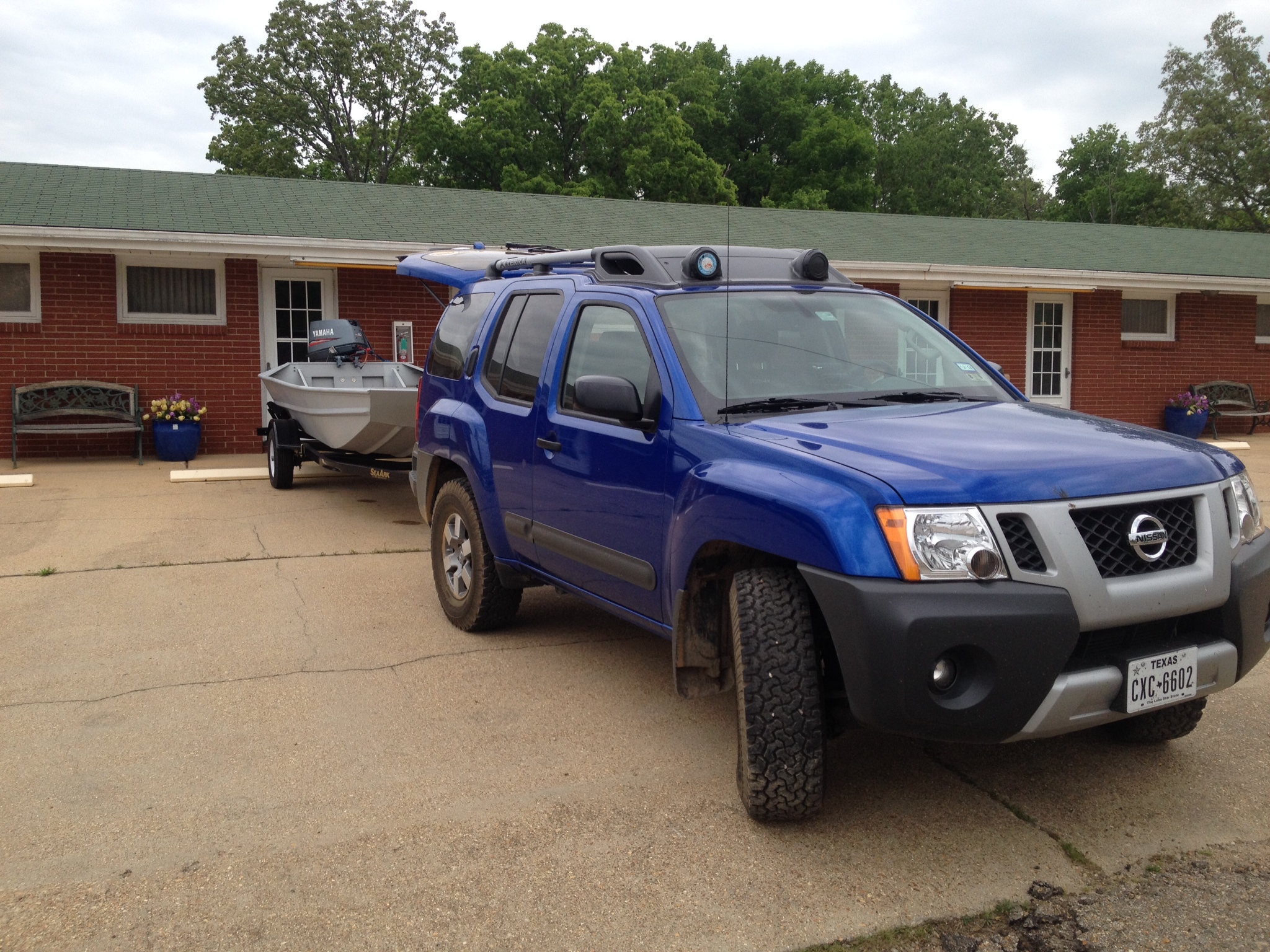
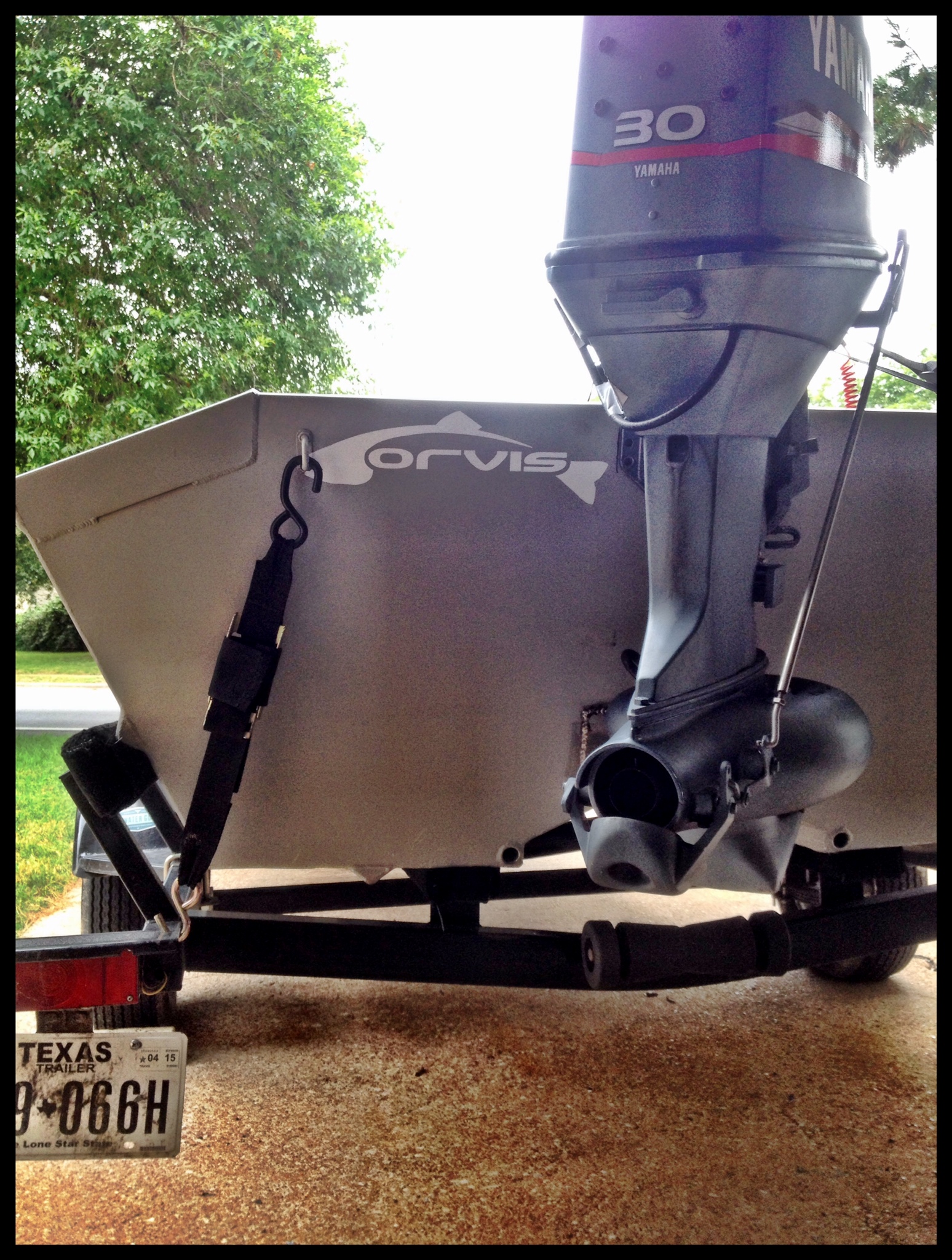



Freddy and the gang were worth every minute of the drive and their knowledge of lower-unit-less engines and boats is beyond awesome. I look forward to my return for a new engine.
Like I said in the previous post, I was going to do the exact same thing to this boat that I had done to the blue one. The SeaArk had a slight V in the Hull and I decided that needed to be addressed first. I had 4”x 4” 90 degree angle aluminium welded into the ribs to create a flat surface to build the flooring on. The flooring was Cedar planks that I sanded, epoxied, sanded, epoxied, sanded, epoxied and then sanded one more time with a final coat of spar varnish for the UV protection. I love wooden boats. My grandfather used to build them. I couldn’t not have the wood floors again, however, they are a huge pain in the ass to fit. I’m a huge fan of brute force and ignorance and in my diving days solved many problems with the idea that if a hammer wasn’t working a bigger one would. Fortunately, I was able to use the same tools my grandfather had used in his boat building; unfortunately his knowledge and experience did not magically pass through the tools as I had hoped it would. He died many years ago and I thought of him a lot while using them mostly during my many moments of frustration in not being able to beat the wood into submission with a larger hammer. The floors look great, however I can see every moment of frustration when my patience (or lack thereof) got the better of me. Guests don’t seem to mind.
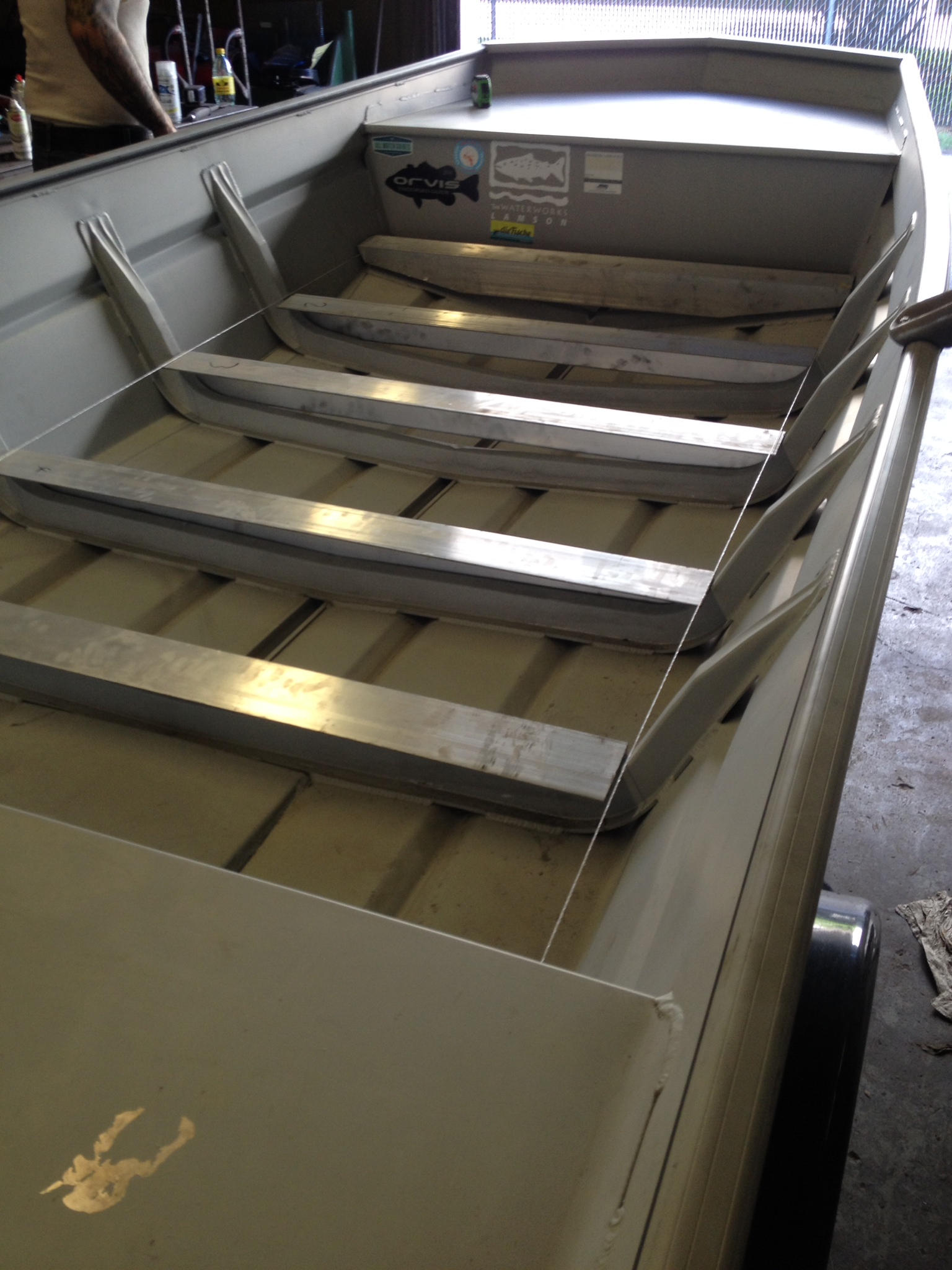
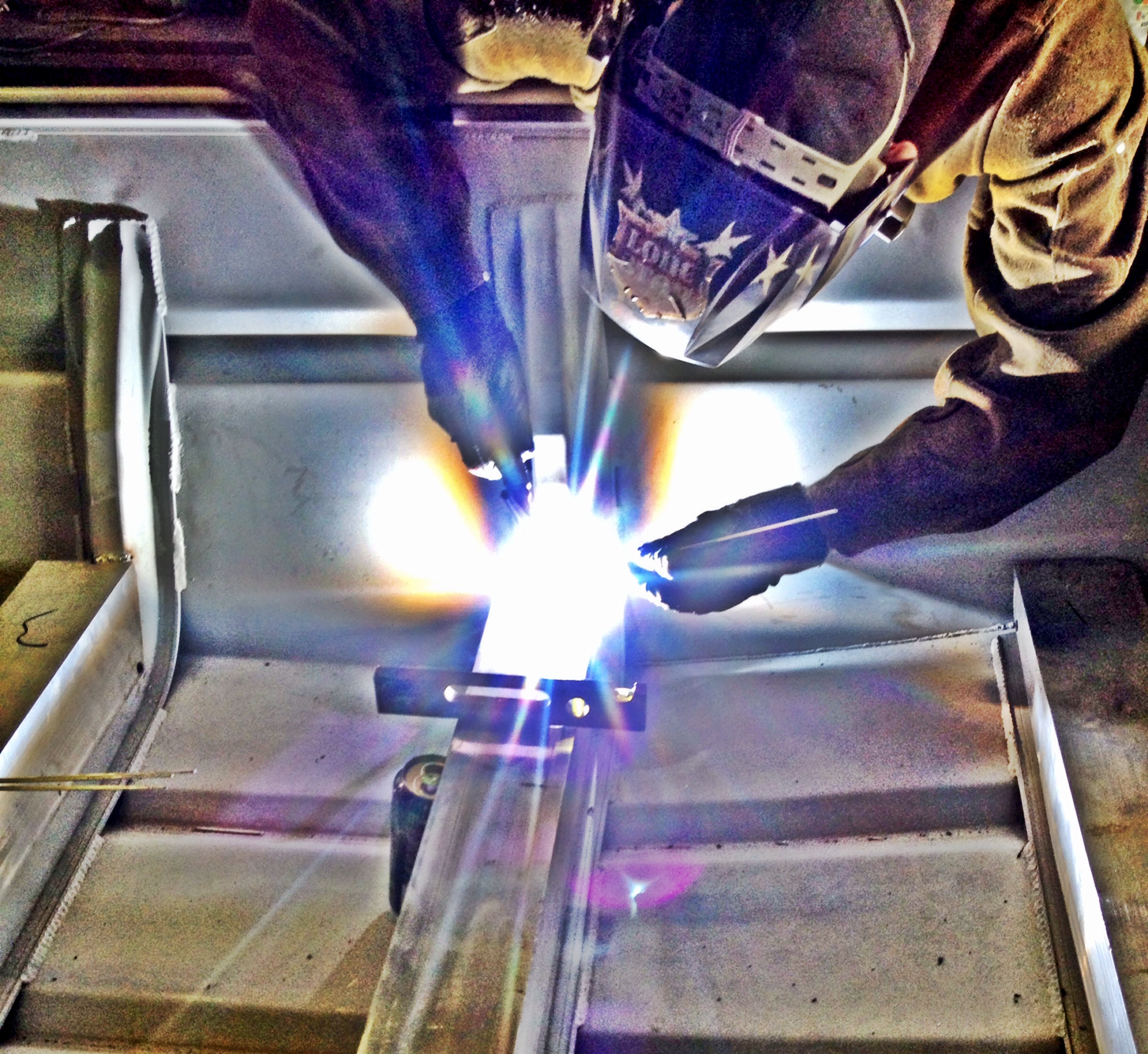
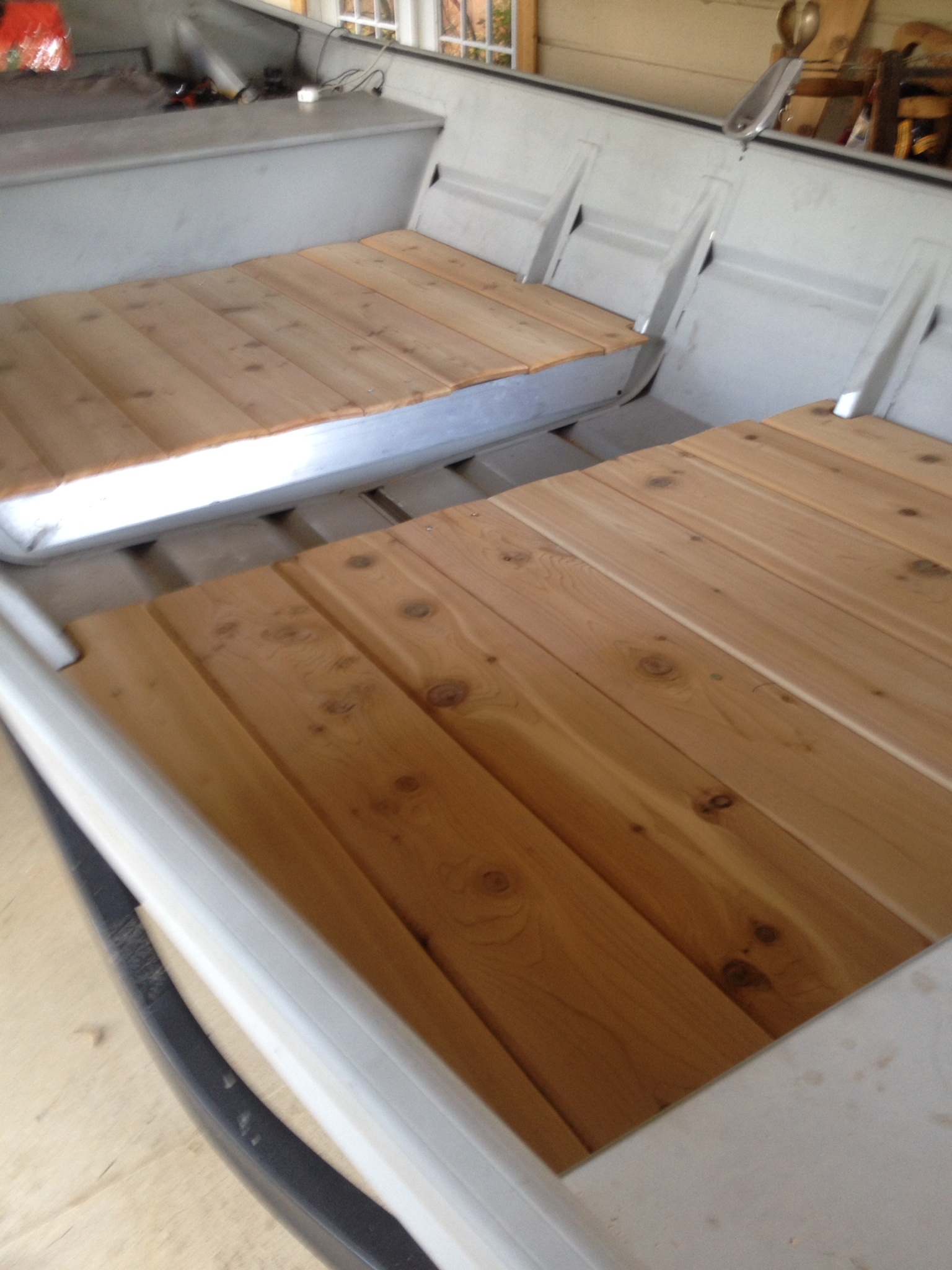

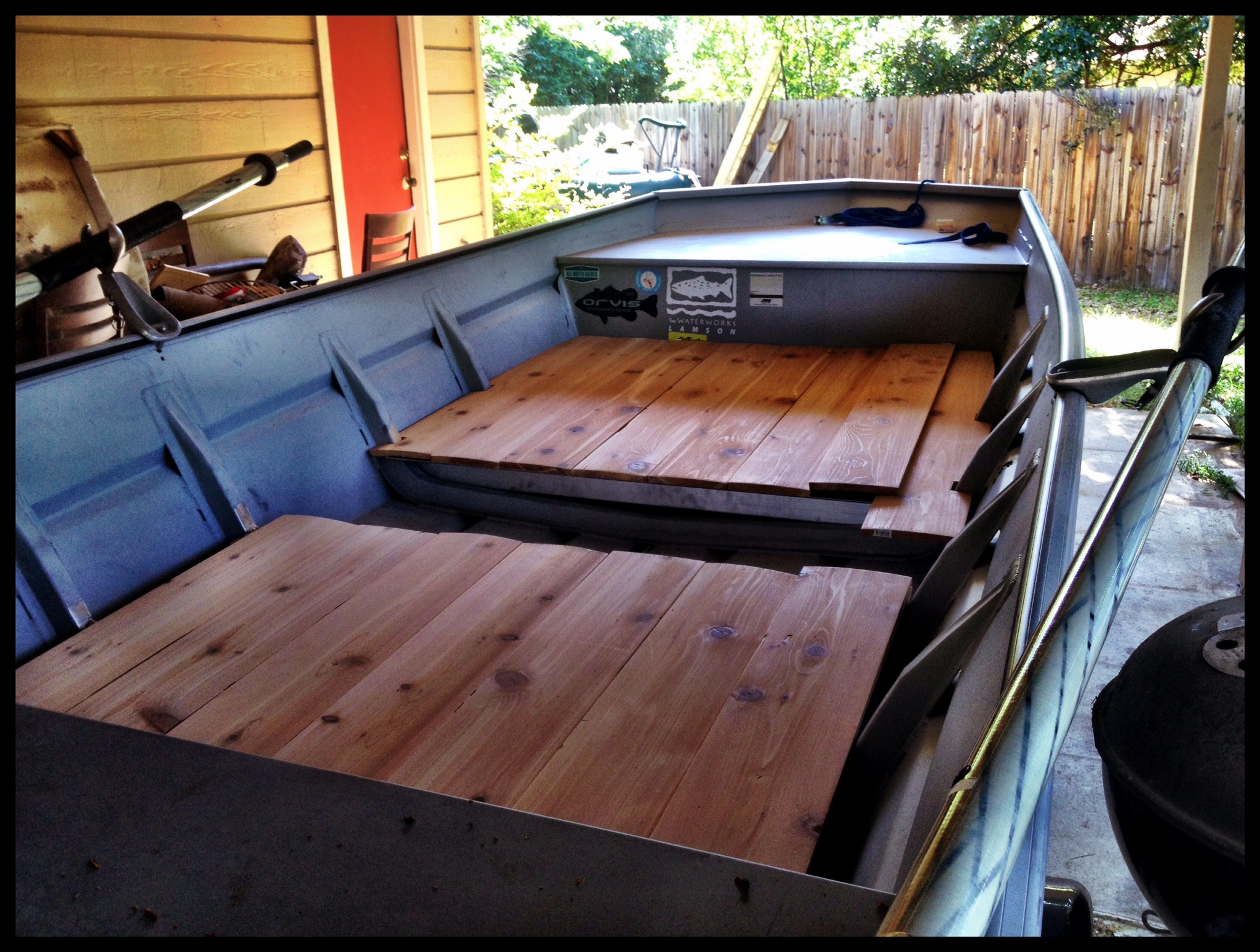
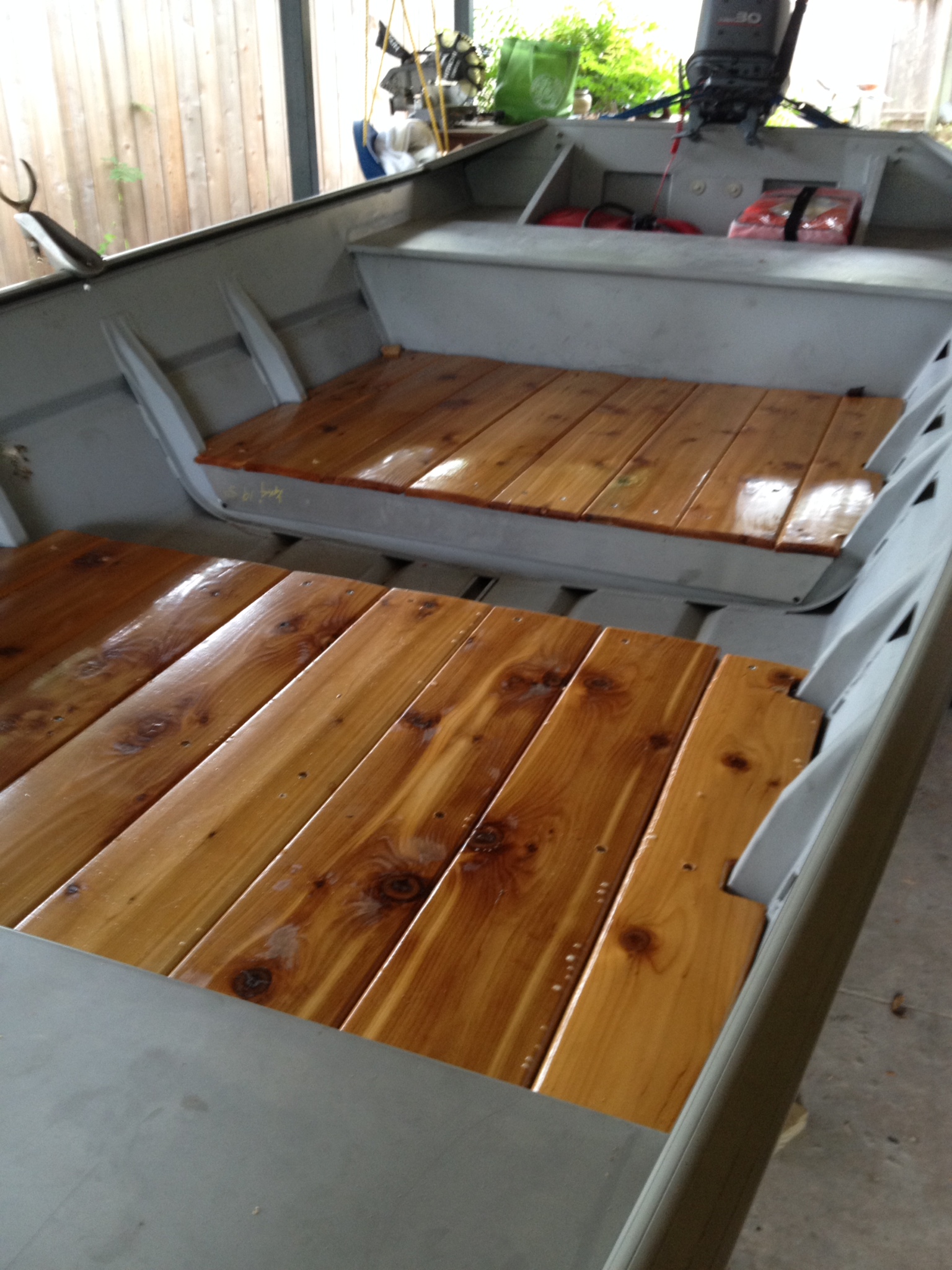
Supervision a year later...
Once the side pieces were cut and fitted to the ribs of the boat the rest went pretty quickly. I also can’t help but to think of my daughter, Poppy, who supervised the last boat, she was only a few months old and was pretty easy to occupy. She’s now almost 2 and has ZERO ability to sit and keep my company.
So that’s the floors. I was, at first, going to do lean bars and knee braces however after the first couple trips I’ve found out they aren’t really needed. It’s my opinion that maybe they create a false since of security for the anglers and without them my clients seem to have a better awareness of themselves and their movements while in the boat as long as I communicate my intentions while on the oars which is better for a lot of reasons. Speaking of the oars, I also didn’t have to create the “frame” like I had before. Oar locks u-bolt directly to the gunwales, which I need to move about a foot forward (boat forward) to give the front guy a little more room.
I, of course, have a laundry list of things to do still with rod holders being the first and some sea deck type stuff for the front casting platform (it gets hot) but since the boat was new there was no need to paint and do all that other nonsense that kept me so busy on the last project. Having the blue boat in my past made doing this boat so much easier, mainly because it was new…
Please contact me with any questions that I most likely did not answer. Alvin, JD and I would be more than happy to share what we’ve learned. We all run different rigs each having their own pros and cons.
Enjoy,
AWG
Dressing for Success: Or at least being able to stay on the water without suffering from heat exhaustion.
While Alvin and JD get to escape the summer heat of Texas, the rest of us will still run trips in the usual manner, however we’re going to be a little more inclined to do “half days” as opposed to the “full day trip” focusing on the early morning and late evenings.
During the next couple months we (as guides and fisherman) expect the brutal heat while on the water and do everything we can to prepare ourselves for it. Many of us guide and have “real jobs” on the side. Our preparation for the heat of the day not only keeps us fishing and guiding but allows us to not need a day off from our ‘day on the water’ to recuperate. Clients that show up dressed for the sun and heat in my experience catch more fish because they are able to fish hard from the first cast to last cast. Sun block, while an important part of the equation, can only go so far.
While on the water whether I’m fishing or guiding during the summer, you’ll find me covered from head to toe in clothing. Big straw hats, Buff sun masks, long sleeve shirts, pants and (yes, gloves). I’ve hyperlinked what I’m wearing in the picture. It seems to counter common sense that wearing so much clothing when its 105 will help keep you cool but it does. With the advances in outdoor clothing these technical garments create a barrier from the sun and “wick” moister (perspiration) in a way that you actually sweat less and what you do sweat evaporates in a more controlled manner. I’m not going to “cut and paste” a bunch of scientific evidence into this article as it is my experience that when I dress in this manner I’m a better guide for my clients and a better husband/father when my day on the water ends and the real work starts upon getting home.
Proper hydration isn’t something you can fix the day of. We all should be drinking water on a day-to-day basis. Bottled water won’t solve a dehydration or volume depletion problem the day of and while on the water, it can actually create serious complications (wearing my paramedic hat now) by flushing out electrolytes that well, are pretty damn important to being alive. As a medic this time of year we see a lot of people that don’t drink enough water on a day to day basis only to have it bite them in the ass after a full day in the sun. I’ve seen some scary cardiac rhythms associated with dehydration in “normal enough folks” that could have been avoided by just drinking a normal amount of water during the days before and wearing appropriate clothing. Shorts and t-shirts won’t cut it.
I think we all could easily drop a small fortune on gear without out a second thought. Personally it doesn’t take much to convince me that some shiny object to replace my perfectly good “older” shiny object is a must have for an upcoming trip (I’ve got a few coming). If you look at clothing as “gear” than it’s easy to justify a couple outfits for the elements. Rationally speaking it makes absolute sense to wear clothing that will keep you in the game longer whether it’s the trip of a lifetime or an afternoon on the Lower Colorado River with us.
See ya on the water!
AWG
I got bored. Tied up some leaders, then decided to write about it.
I first need to say that I enjoy building my own leaders. Most likely the store bought ones are better. (However, I cut those up too.) Also it gets expensive if you’re as tough on stuff as I am. Many in our community enjoy tying flies, I don’t. I enjoy building my own leaders. My nymph rig is not my own as I’ve cut and pasted what I like from others I’ve seen. It also needs to be said that Indicator Nymphing is pretty new to me. Having not grownup around tail waters I learned other ways.
My biggest issue with bobbers is that they destroy my leaders. Okay, “destroy” is probably the wrong word. My leaders seem to get all jacked-up from them though. You’ll notice a couple things in my rig. First, I run my bobber “inline” and secondly, I use a swivel. If you don’t see it, trust me it’s there. I’ll leave the swivel alone for now to let that digest. The nail knots of old fly-line secure the bobber where you want it on the butt section giving you your desired depth. However, you can make adjustments to your depth by just sliding the nail knots up and down the butt section. I’ve tried this on tapered leaders without much success. I think the declining diameter of the butt section allows the nail knots to slip. For comparison, this leader recipe will be pretty darn close to an Orvis 9’ 5x knotless tapered leader.
I use 3-4 feet of 30lb MAXIMA Ultragreen Mono (0.22”) for my butt section. MAXIMA is great stuff and has the stiffness required for a butt section. I’m pretty diligent on my lengths, for various and complicated reasons, so when I say 3-4 feet it is 3 feet or 4. I cut a longer section to work with and thread the bobber on inline. Then with old fly line tie in 2 nail knots on either side. Make them good and make them tight. I do 5 turns in mine. After you’re done with that, tie your perfection loop in one end and cut down your leaders butt section to the desired length keeping in mind the knot. (I’m a perfectionist and, yes, I will start over if it’s an inch off.)
For my mid section, I use Berkley VANISH Fluorocarbon. It’s supple and a good transition to the tip. With a 30lb butt section I’ll use 10lb test (0.11”) tied in with an improved blood knot. Capt. Dave Hunt, a tarpon guide whom I’ve fished with, instilled in me the importance of choosing the right knot for the right application, which I appreciate. Because of the drop in diameter between the two, I feel the improved is a better choice but I could be wrong. To finish off the mid section I use a swivel.
If you’ve never used a swivel or a tippet ring you should give it a shot. I am constantly breaking off, knotting up, cutting back…etc…etc… my tip section. The swivel helps with the cold finger tie-in if you have to completely redo your flies because of a tree, besides the extra little weight is good and I promise the fish don’t care. The business end of the rig is completely up to you.
For my tip section, I will tie to the swivel 1-2 feet of 4lb Berkley VANISH (0.009”) then my Frogs Hair Tippet 5x with a good ole’ double surgeons knot. I like the Frogs Hair because I get a deal on it and I’m nerdy. The gamma technology and their proprietary process is fun to read about and just like the Vanish it is made in the USA.
So there ya have it! Take it or leave it, use it or don’t. Just go fishing.
Tight lines
W
A Night of Friends and Flip-flops
I had a great time as the guest tyer at Sportsman’s Finest (SF) Tuesday night fly tying class. We tied up the infamous Flip-flop Popper designed by All Water Guides’ head guide Alvin Dedeaux. We had a packed house and plenty of nice poppers for everyone’s fly boxes at the end of the night—bass be aware! The Flip-flop Popper is a staple in my bass fly box and accounts for the majority of all bass caught on the fly. If you want the “recipe” stop by SF and they will set you up with everything you need.
Watch All Water Guides’ Best of 2012 video to see the Flip-flop Popper in action: https://www.facebook.com/video/video.php?v=10200769969428745
As always, the SF crew—Greg, Stacy, Chuck, Ted, and Lindy—was amazing. The Austin area is fortunate to have a great fly shop that always goes the extra mile for it’s customers and the greater fly fishing community. Thanks again to SF and Greg for the invitation!
Remember folks, SUPPORT YOUR LOCAL FLY SHOP!
















